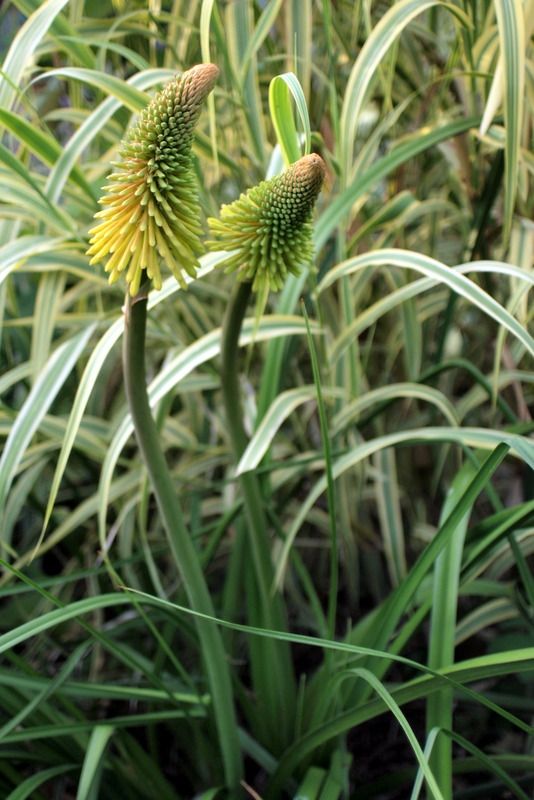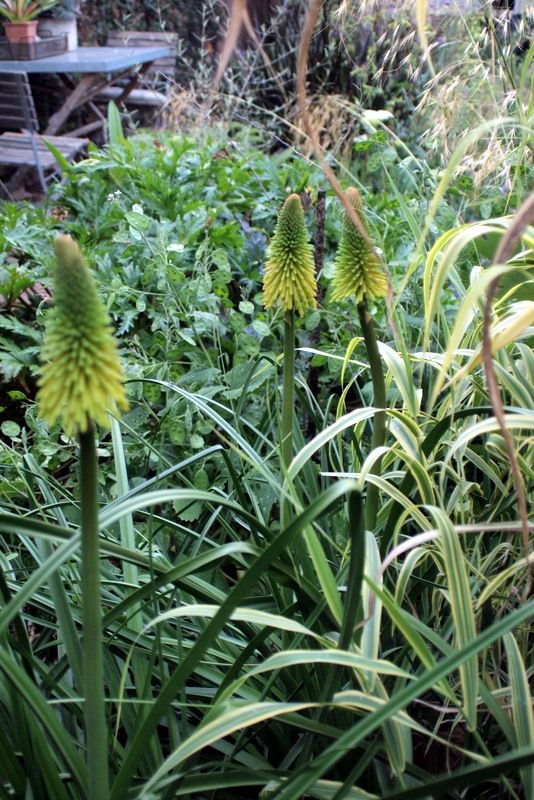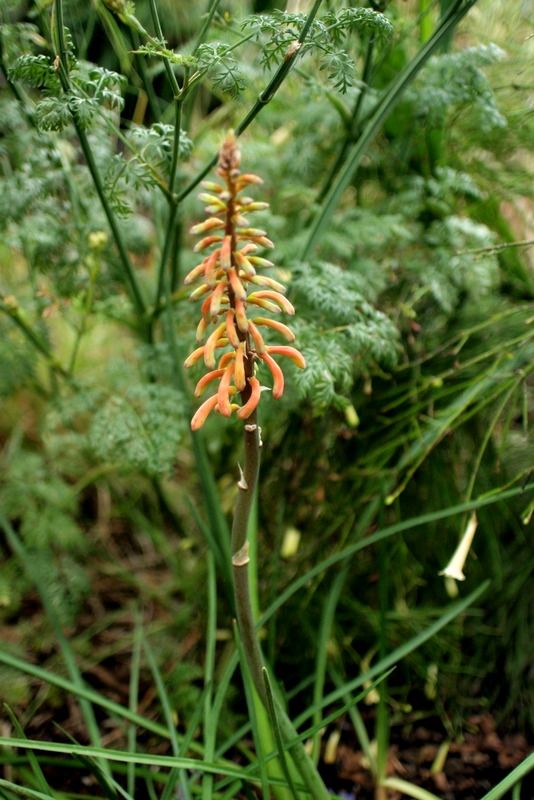These get moved around the garden quite a bit, one of the reasons I can never keep track of their proper names. This may possibly be Kniphofia ‘Glow,’ but I wouldn’t swear to it. Currently, this remaining clump is deep in the back, near the compost pile, an out-of-the-way place for experiments, yes, but also a last-chance proving ground for the beautiful but exasperating ones like kniphofia. For a plant, being moved ever closer to the compost pile is very much like placing a shovel at the ready near the plant in question, a not-so-veiled threat to clean up your act or risk being converted to compost. Threats aside, it’s also an open, sunny site that has the added advantage of hiding their copious leaves from view, which is the main reason they get uprooted so often. Kniphofias really do claim their fair share of garden real estate, and then some.

But when they’re in bloom, all is forgiven.
Just look at that demure, beseeching bend to their necks. “Why, we’re nothing but beautiful and no trouble at all!”
Haven’t we all tried that line before?

Back by the compost bin, they’ll have to duke it out with bare-knuckle streetfighters like macleaya, Arundo donax, and Japanese anemones.
Mazeltov. May the best plant win.

But just to prove I can occasionally be nice to plants and not always the severe taskmaster, here’s a kniphofia I just gave a prime location right outside my office, Kniphofia thompsonii var. snowdenii. I moved it from the front garden which is undergoing an impromptu revision as a result of planting a tree in the midst of all the sun lovers. You’ve gotta keep plants on their toes. Nobody is allowed to get complacent around here. The tree, Acacia podalyriifolia, has taken us all by surprise by growing in leaps and bounds, necessitating some reshuffling this spring as sunny conditions turn swiftly to shade under the acacia’s rapidly expanding canopy. I really should have moved this kniphofia anyway to a site with steadier moisture. It had practically none in the front garden.

Because here’s what a happy, mature clump looks like, photographed at Mendocino Botanical Garden 8/11. It looks quite different from my Kniphofia thompsonii var. snowdenii, but I think this is the effect of good culture and conditions it likes. And doesn’t everything look different in a botanical garden anyway, versus a small home garden where space is on a stingy budget? But there may be various forms in circulation. Confusing the issue is a kniphofia also listed as K. thomsonii, whose photo looks very similar to mine on Far Reaches Farm’s website, that I’ve also seen referred to as K. thomsonii var. thomsonii. Whatever its correct name, the blooms are more open and aloe-esque, the leaves thinner and tidier. Even in the poor conditions of the front garden, it bloomed more frequently than the garden hybrids, and the leaves stay neat and low. This one now has pride of place, sited well away from the compost bins…for now at least. Any clarification on the names thomsonii/thompsonii is most welcome.

Love this post Denise. I do think the non-performers or ‘bordering on eyesores’ plants benefit from a good threat. LOL
Ruthless you are but funny. Perhaps you could give your “retirement community” a name. Shady Pines perhaps?
Whatever the name, they are really pretty! The shape is so fun and different than most things in the garden.
Correct spelling is Kniphofia thomsonii. Native to east Africa. The difference between K. thomsonii var. thomsonii and var. snowdenii (correct spelling) is that the latter has hairs on the lower portion of the flower. Probably only visible with a 20x lens.
The picture in your garden looks like thomsonii; the last one looks like a hybrid.
It’s funny that the first time I ever saw a kniphofia was after we moved to Denver; never saw any in Long Beach or Los Angeles in the 1950s, that I recall. (I was gardening even then.)
There were dozens of species and hybrids in the garden here until last winter; lost them all to wet, not cold.
@Deanne, it never hurts to shake a shovel in front of ’em — or a compost pile 😉
@Peter, if only plants would cooperate with our grandiose vision, right?
@Cassidy, the shape and clear colors are great, aren’t they? I think they’re excluded not only because of size but because strong orange and yellow are not wanted.
Bob, the hero! When Hortus doesn’t have the answer or the web, I’m stumped. What a minute difference with snowdenii (I spelled it correctly one time at least.) Kniphofia still aren’t seen around local much. So sorry to hear you lost yours! There’s still a bit of thomsonii left in the front garden — let me know if you’d like to try it, but it sure sounds like you’re already well acquainted with it!
I just bought one of the K. thomsonii var. snowdenii this past weekend, and am giddy as a school girl over the prospect of seeing those pretty flowers in my garden. Hopefully it will perform in the conditions I have, and not be worthy of the compost pile quite yet – time will tell. 🙂